Foot care is one of the most neglected horse management practices. Most lameness that impairs the usefulness of a horse can be prevented by proper foot care and reasonable management.
Foot care should be as routine as feeding and watering. It should include:
- Routine cleaning
- Periodic trimming
- Corrections of minor imperfections
- Treatment of foot diseases and injuries.
Most foot care practices can be done by the average horse owner. However, it is important to know when to seek the help of a professional, especially for corrective shoeing and disease treatment and control.
To understand proper care of a horse's feet, first study and understand the structure of the foot and the functions of its various parts. The major parts of a horse's foot are the hoof wall, coronet, sole, frog and the internal structures such as the bones, cartilage, tendons and connective tissue. Internal structures will be discussed briefly in this guide.
Hoof wall
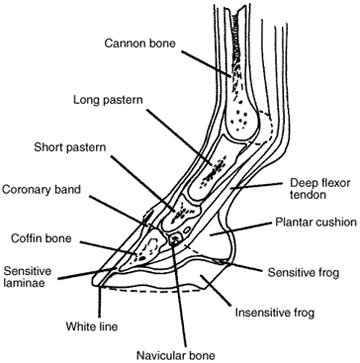
The hoof wall is a horny substance made up of parallel fibers (Figure 1). It should be dense, straight, and free from rings (ridges) and cracks. Viewed from the side, the wall at the toe should be a continuation of the slope of the pastern.
The main functions of the wall are to:
- Provide a weight-bearing surface not easily worn away
- Protect the internal structure of the foot
- Maintain moisture in the foot.
Usually, the hoof wall is thicker at the toe than at the quarter and heel. The hoof wall is protected by the periople, a varnish-like coating that also holds moisture in the hoof.
Coronet
The coronet, or coronary band, is the source of growth for the hoof wall. It is directly above the hoof wall and is protected by a thick layer of skin and dense hair. A healthy foot will grow about 3/8 of an inch per month. A change in the rate of growth of the hoof can be caused by a change in the amount of exercise, the ration, the onslaught of illness, and the general state of health and condition of the animal. Injury to the coronary band can result in irregular growth of the hoof wall and can develop into a permanently unsound hoof wall.
The hind feet may grow faster than the forefeet, and unshod feet may grow faster than shod feet. The feet of mares and geldings seem to grow faster than those of stallions.
Sole
The sole of the foot is a horny substance that protects the sensitive inner portions of the foot. It should be firm, slightly concave and of uniform texture. The horse has no feeling at the exterior sole surface.
A flat-footed horse tends to receive more bruises and injuries to the sole. Also, horses that have experienced founder and have developed a dropped sole are more easily bruised at the sole.
Frog
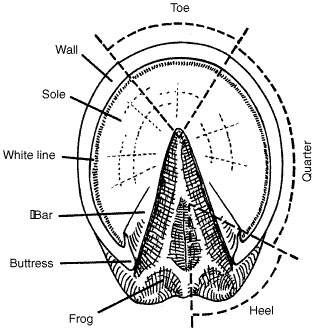
The frog, located at the heel of the foot, forms a "V" into the center of the sole (Figure 2). The frog is a spongy, flexible pad and is also a weight-bearing surface. It is the intermediate organ between the plantar cushion and the source of pressure from the horse's weight. The frog is differentiated from the sole of the foot by two lines called commissures.
The condition of the frog generally is a good indication of the health of the foot. Without proper flexibility, expansion and ground contact, the frog cannot perform its function in complementing the circulation of blood and the absorption of shock throughout the foot.
Internal foot structure
To be able to provide proper foot care, first gain an understanding of some of the important internal parts of the foot and their functions.
- Coffin bone provides the shape of the foot and the rigidity needed to bear weight.
- Plantar cushion expands and contracts to absorb shock and pumps blood from the foot back toward the heart.
- Navicular bone serves as a fulcrum and bearing surface for the deep flexor tendon, which is responsible for extension of the foot as it progresses through a stride.
- Sensitive laminae serve as a means of attachment for the hoof wall and the coffin bone and also as the main area of blood circulation within the foot.
Routine foot care
Disease organisms concentrate where animals are confined, so cleanliness is important. Horses kept in a stall or small pen should have their feet picked or cleaned daily to reduce the risk of thrush. Thrush is the condition resulting from bacterial penetration into the frog and surrounding area. The bacteria produce a foul odor and cause the frog to become soft and mushy. If allowed to go untreated, serious lameness can result and extensive treatment will be necessary.
Routine daily foot care means regular use of the hoof pick to clean the horse's feet. A fine-bristled wire brush also is useful for cleaning the sole, frog and hoof wall. Take care not to damage the periople with too much pressure from the wire brush; the result would disturb the moisture balance of the foot.
Foot cleaning
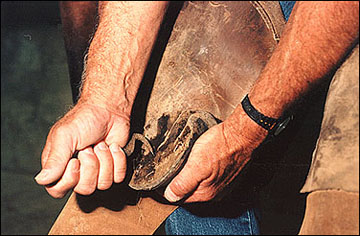
When picking the foot, use a hoof pick and clean from the heel toward the toe, being especially careful to clean the commissures on each side of the frog and the cleft of the frog itself (Figure 3). Don't attempt to open the heel excessively, as this weakens the area and interferes with proper contraction and expansion of the heel.
After riding, clean the sole and check for gravel or other foreign objects that could be lodged in the natural depressions of the foot. A nail, gravel, stick or other object can work into the foot and cause lameness of long duration. Objects have been known to exist in a horse's foot for as long as a year before emerging at the heel or along the coronet. When a foreign particle emerges at the coronary area, a sore, called a quittor, usually develops. This problem can easily lead to serious infection.
Maintain moisture in feet
Moisture in the horse's feet helps to maintain flexibility and prevent cracking. Most of the moisture needed in a healthy and well-protected foot can come from within.
Extremely wet conditions such as a muddy lot or wet stall promote rapid drying of the feet; the natural oils and protective films of the foot are eroded from constant contact with external moisture.
One way to maintain proper moisture in the foot is to regularly apply a good hoof dressing containing some animal fat such as lanolin. If the dressing is not a petroleum derivative, it can be massaged into the coronet, the frog and the sole as well as on the hoof wall. The dressing helps to keep the sole pliable and eliminate dead tissue around the frog and heel. Also, massaging the coronet stimulates growth of a healthy new hoof wall.
Trimming maintains foot balance
Trimming of feet is important, although not needed as frequently as cleaning. Trimming should be done at about four-week intervals on horses kept in stalls or paddocks, or about six-week intervals for horses used heavily or running in pastures.
The main goal in trimming is to retain the proper shape and length of the foot. Most people should feel comfortable in pulling shoes and trimming feet while they wait for the farrier.
The bottom of the foot should be kept level and the inside and outside walls should be maintained at equal lengths.

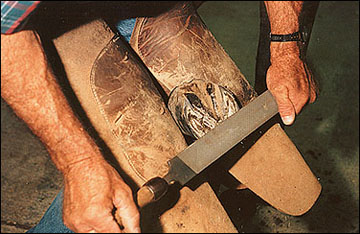
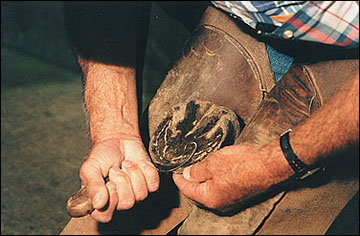
The hoof wall should be trimmed with nippers to remove excess length (figure 4), then a rasp should be used to smooth and level the bottom of the foot. Be sure to rasp from the heel through the toe with each stroke to prevent uneven areas in the hoof wall (Figure 5).
The white line is external evidence of the lamination (sensitive laminae) between the hoof wall and the coffin bone. The sole of the foot is usually of uniform thickness in a normal horse. Because of that, the sole should not be trimmed to an unnatural shape. To do so would cause parts of the sole to be dangerously thin and tender.
Trimming the sole, referred to as lowering the sole, is done to keep the pressure on the hoof wall rather than on the sensitive inner parts of the foot. The dead, flaky tissue should be trimmed from the sole. Live tissue, elastic when stretched between the fingers, should not be trimmed away (Figure 6).
Don't trim the frog excessively; it should contact the ground with each step. Trim the frog only enough to remove dead tissue and to provide a uniform and adequate fissure along the junction of the sole and the frog.
After the bearing surface has been rasped to a level surface of proper length, the edges of the wall should be rounded if the horse will not be shod. This prevents chipping and peeling as the foot contacts rocks, logs or other obstructions.
Maintain hoof wall angle
Maintain the proper angle of the hoof wall in relation to the ground and the angle of the pastern. Shoes that are left on for too long change the angle of the foot relative to the pastern and can cause lameness. When possible, the angle of the hoof wall should approximate the angle formed by the shoulder and the pastern — usually 50 to 54 degrees.
Since the hoof wall is narrower at the heel than at the toe, heels wear first, whether the horse is barefoot or on shoes. Low heels put more stress on the tendons of the leg. If a horse is shod at a 50-degree angle, this angle may change. A 50-degree angle might be down to 46 or 47 degrees in four to six weeks. This greatly affects the action of the horse and puts more strain on tendons and ligaments.
As the hoof grows larger, the walls at the heels will overlap the shoe. When a shoe presses on the bars, there is serious danger of producing corns in the foot. Running a horse with shoes that have been left on too long also can cause bowed tendons. Regular trimming and shoe re-setting are essential in avoiding these problems.
Foot angle varies from breed to breed and much variation is found among horses of the same breed. Generally, the Western breeds have steeper pasterns and a greater angle at the ground than the other breeds. Unless some correction is needed, as in forging and scalping, the foot should be trimmed to its natural angle, because any change would result in stress in other areas of the column of bones of the leg.
Trim the heels low enough to promote expansion and prevent contraction of the heels. The main concern is to trim often enough to prevent cracking and uneven wear, which could eventually contribute to the improper set of the feet and legs. With a little practice, most horse owners should be able to routinely trim feet of horses that do not need corrective work. It is wise, however, not to take a chance on compounding a problem on horses that need corrective trimming. To prevent harmful mistakes, seek the help of a professional farrier when trying to correct an improper turn or set of the feet and legs.
Founder brings feet problems
Fat horses tend to have problems with laminitis (founder). This is especially common among horses with some Shetland pony breeding. Grass founder in the spring produces more laminitis than any other single cause. If your horse is fat, grazes abundant grass, and is not exercised, there is great risk of laminitis.
Laminitis commonly causes lameness. Horses with laminitis have extreme pain and soreness, especially in their front feet. They try to bear weight on their back legs and lighten the front end as much as possible by carrying their front feet forward and their back feet up under their bodies. Horses showing signs of laminitis should have immediate attention from a veterinarian.
Therapeutic trimming and shoeing may make a horse with laminitis sound enough for light work and normal reproduction.
Give nail pricks prompt attention
Much lameness results from nail pricks. Horses should not be ridden in areas of trash and boards containing nails. Injury caused by nails can ruin a horse.
As soon as a nail prick is identified, give prompt medical attention and pack it to prevent reinfection by ground-borne disease organisms.
Corrective trimming
The most common deviations from a normal set of feet and legs are toe in (pigeon toed) and toe out of either front or rear feet. Other problems commonly corrected by trimming are cocked ankles, buck knees, calf knees, sickle hocks and slight rotations of the cannon bone. Also, some common faults in movement of feet in stride — forging, scalping, interfering and brushing — are corrected by careful trimming.
The most important aspects of good foot care are regularity, frequency, cleanliness and the use of proper corrective measures.
Handling the feet
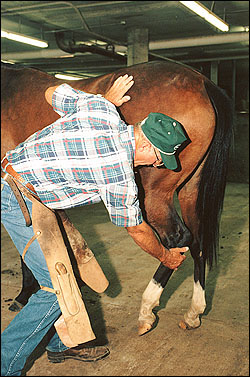

Learning and practicing safe handling of the horse's feet are important steps in performing routine foot care. Horses should be taught early in life to yield their feet.
Most horses are worked more from the left side than the right, so begin working with the left front foot. Rub down the leg toward the foot with your right hand while your left hand is on the shoulder. Push off with your left hand if you need to move away.
Squeeze the tendon to get the horse to yield the foot if it won't do so otherwise. Move the hand in front of the canon or fetlock as the foot raises. Position the foot firmly between your knees. If the horse struggles and wishes to regain its foot, let it do so. You can't hold a front foot if the horse rears. Repeat the procedure until the horse learns to yield its feet willingly.
To lift a hind foot, keep one hand near the hip and go down the leg slowly with the other (Figures 7 and 8). Work in close to the horse. Pull forward on the canon until the horse yields its foot. If you feel tense muscles, go more slowly. Step promptly under the raised foot with the inside leg and set the foot above your knees. Lock it in place with your elbow over the hock and your toes pointed toward each other. Hold the foot in this position so both hands are free to work.